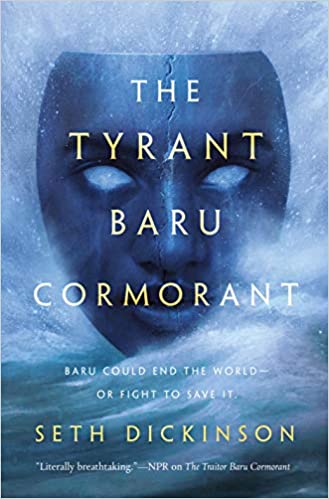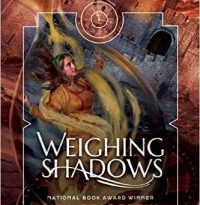Paul Di Filippo Reviews The Tyrant Baru Cormorant by Seth Dickinson
 The Tyrant Baru Cormorant, Seth Dickinson (Tor 978-0765380760, $32.50, 656pp, hc) August 2020.
The Tyrant Baru Cormorant, Seth Dickinson (Tor 978-0765380760, $32.50, 656pp, hc) August 2020.
Five years ago, I was privileged to review, in the online wing of this fine publication, Seth Dickinson’s debut novel, The Traitor Cormorant. I praised his prose as ”deft and forceful,” while deeming his characters ”all built to clever and deep dimensions, with fully human qualities and motives.” Finding his novel to be a tasty blend of C.J. Cherryh’s early planetary romances and Samuel Delany’s revisionist Nevèrÿon fantasies, I concluded by saying that Dickinson had succeeded ”in building and exploring a morally treacherous world populated with exotic characters whose hearts nonetheless align with ours.”
Of course, I had no way at the time of foreseeing what refinements or surprises or critical illuminations subsequent volumes would bring. But now that I’ve caught up with book two, The Monster Baru Cormorant, and now that book three has arrived, I discover that while I stand by all my earlier assessments, I have to add a few fresh notes, and, of course, evaluate the newest entry and the series as a whole.
First, I want to observe that while Traitor struck me as somewhat mannerpunk in its elaboration of ceremonies and politesse, the series has definitely gone grimdark.
Also, I did not give enough weight to Dickinson’s rich and exotic worldbuilding and culture-minting. This universe hangs together organically, and the distinct societies are multiplex and deep.
Thirdly, we could entertain some useful comparisons with elements of Robert E. Howard’s landscapes and figures, or those of Fritz Leiber’s more sophisticated sword and sorcery tales. Although utterly postmodern, this series revels in pulp tropes and vigor.
And finally, with the huge scope of the tale now revealed, we can evaluate Dickinson’s skills at plotting and managing a huge narrative arc.
To very briefly get us up to speed.
Our protagonist, Baru Cormorant, is a very clever young woman with certain talents of mind and a merciless utilitarian amorality. Born on the idyllic island of Taranoke, where matters of gender, family, and sexuality are much more fluid than in the hegemonic Empire of Masks, she seems destined for a quiet and unremarkable life. But her island is soon conquered and she finds herself recruited, like a talented Celt by Imperial Rome, into service with the enemy. She learns the ropes, relying on her talent for numbers, facts, and strategies, and works her way up the ladder of success, but then seemingly goes over to a group of rebels, becoming their leader. However, her longterm individual goals involve betraying the rebellion and avenging the conquest of Taranoke. She does so, shattering the mutiny and handing the Empire a big victory, emerging not unscathed, but with a neurological deficit (shades of Gene Wolfe’s Soldier of the Mist).
The Monster Baru Cormorant opens with death on every side. Baru is forced to execute her lover, Tain Hu, to maintain her façade of loyalty, while elsewhere a rebel named Abdumasi Abd (whose fate will intertwine with Baru’s) suffers excruciating defeat, torture, and capture. Having concluded her immediate warfare activities onland, Baru is next tasked with travelling south by ship over the central Ashen Sea around which all the countries pivot, in search of a mysterious item/entity/organism/organization known as the Cancrioth. Unfortunately, she is beset by a score of rivals, enemies, friends-worse-than-enemies, random attackers and others (chief of whom is Tain Hu’s vengeful assassin cousin, Tain Shir). What results is a cataclysmic, shambolic odyssey that ultimately sees Baru lose a couple of fingers and find the Cancrioth.
While stuffed and overstuffed with vivid set pieces, sharp character interactions (so many colorful insults, dire execrations, Shakespearean boasts, arrogant challenges, and dirty, dirty swears!), and revelations of different venues, this installment does suffer a little from the mid-series holding action pattern of all trilogies.
The culminating book under our gaze today is even more jam packed with action, reveals, reversals, and Machiavellian plots and counterplots, but it moves rather more linearly and stepwise towards a truly fine and resonant and surprising climax, one which, not to give too much away, revolves around, of all anti-swashbuckling maneuvers, a stock-market scheme. Thus does Dickinson remain true to the first book’s original presentation of Baru as Stealth Accountant.
Before we get there, Baru and company will have to traverse infinite perils, which include but are not limited to keelhauling, lobotomies, meningitis, a pandemic deliberately unleashed on the island of Kypranoke, with microbes whose source species is bats (timely indeed!), naval battles, swordfights, drug dreams, and more. Baru gets a reunion with her parents, for whom she has been doing all this, and it proves less than ideal. Her neurological deficit is shown to be a surprising and even touching survival adaptation. She reconciles with enemies and falls out with friends. The Cancrioth, a creepy, sorcerous biopunk cabal of sorts, venture out of hiding to become a force on the chessboard. And after rough times afield, Baru finds even more deadly, albeit superficially genteel challenges in the imperial city of Falcrest.
Dickinson believes in the Laumerian ”test to destruction” philosophy of character exfoliation. The excruciations that Baru and the others must undergo comprise a litany of physical and mental assaults, all vividly detailed. There’s the grimdark aspect, but noirish elements also pervade, insofar as we define noir as a genre focused on corruption and amorality. Baru, that ”feral arithmetic ghoul,” indeed earns her three titles of monster, traitor and tyrant. Still, it’s hard to fault her actions, given the harshness of her world.
Dickinson can construct a five-page fight scene that never falters, and then turn around and describe that emotionally charged parental reunion with some tenderness. He tops himself with a vision that Baru has towards the end of the book, after all the dust has settled and she’s achieved a mixed victory: she sees the future she’s ensured as a kind of glittering utopian reward for all the suffering people of the Empire. But will it come to pass, given the mystery embedded in a small coda that posits more challenges just ahead?
Atop all this, Dickinson lays a tripartite narrative track. The sections labeled ”Now” find a mysteriously disabled Baru with her patron Farrier as she tries to recall her own forgotten saga, much like Rush That Speaks in Crowley’s Engine Summer. The bulk of the text is the realtime action that picks up right where the second book left off. And then there are the flashbacks to events 25 years gone. This alternation of these separate eras provides a pleasant jigsaw-puzzle nature to the plot, and of course, Dickinson’s prose is always cinematically lush, replete with striking figures of speech:
Tain Shir moved among them, killing, killing again, impaling the Pranist’s cadre one by one, twisting them by the bowel as if the spears were levers and their bodies were the fulcrums of some ancient doors.
Now that this voyage is complete, I think the accomplishment which the Baru books most resemble in contemporary fantasy is Robert Redick’s Chathrand Quartet. Both series blur the line between heroism and villainy in an exotic world where the most bizarre doings and creatures serve as living analogues for universal problems and aspirations and emotions that the reader faces every day.
Paul Di Filippo has been writing professionally for over thirty years, and has published almost that number of books. He lives in Providence RI, with his mate of an even greater number of years, Deborah Newton.
This review and more like it in the June 2020 issue of Locus.
 While you are here, please take a moment to support Locus with a one-time or recurring donation. We rely on reader donations to keep the magazine and site going, and would like to keep the site paywall free, but WE NEED YOUR FINANCIAL SUPPORT to continue quality coverage of the science fiction and fantasy field.
While you are here, please take a moment to support Locus with a one-time or recurring donation. We rely on reader donations to keep the magazine and site going, and would like to keep the site paywall free, but WE NEED YOUR FINANCIAL SUPPORT to continue quality coverage of the science fiction and fantasy field.







